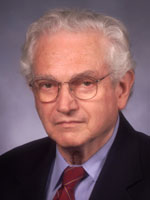
Marshall Nirenberg
National Institutes of Health
Miming the Genetic Code
The Gordon Research Conferences have supported important exchanges of findings about the genetic code and helped scientists working in the area learn new methods. In 1961 Heinrich Matthaei and I published the “poly-U experiment”: we built a strand of messenger RNA (called the “poly-U strand”) made only of the base uracil. Our experiment caused a bit of a sensation because it proved that ribonucleic acid acts as a genetic messenger. In the year that followed, we were busy deciphering the genetic code at the National Institutes of Health–and going to a lot of symposiums–when I attended my first Gordon Conference on nucleic acids.
Fritz Lipmann of the Rockefeller Institute, the greatest biochemist of his time and a magnificent scientist, chaired a session of the 1962 conference called “In Vitro Polypeptide Synthesis: Effects of Nucleic Acids” where I presented a paper. Joseph Speyer from Severo Ochoa’s laboratory at New York University also gave a talk. Ochoa was one of our greatest competitors, but he had received me very graciously in his lab in New York at one time. Heinz Fraenkel-Conrat talked about the collaborative work we had done together on protein synthesis when I visited him for a month at the University of California at Berkeley.
I chaired a session in 1965 on polypeptide synthesis and another in 1967 on protein synthesis. When I moved into the field of neurobiology in the 1970s, I found that Gordon Conferences were critical meetings in this discipline as well.
I always thought the Gordon Conferences were among the best meetings of the year. You not only heard the latest things that were happening in the field, but you also had a chance to meet the participants and get to know them personally.
The informality of the sessions probably left the deepest impression on me. After all these years I still remember a “talk” Seymour Benzer gave in 1962 using two blackboards with pieces of words written on them. He selected these pieces just by pointing at them, and he gave his whole seminar–all fifteen minutes of it–without saying a single word. You might have thought he was trying to simulate the genetic code in mime (he was “talking” about RNA), but actually he was just trying to be funny. We were elucidated and entertained at the same time.